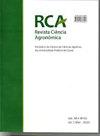Propagation potential of commercial pineapples and impact of the subculture interval on production planning1
IF 1
4区 农林科学
Q3 AGRICULTURE, MULTIDISCIPLINARY
引用次数: 0
Abstract
- Me asuring the propagation potential of any variety, considering micropropagation to obtain the seedlings, has received little attention from researchers. The use of unusual statistical techniques, such as geometric growth rate and exponential regression, can produce important information for planning and applying subcultures based on their in vitro behaviour, which may indicate the need to improve the protocol and to better understand the effects of interval trials and subcultures. The aim of this study was to evaluate the effects of three different subculture intervals on the propagation potential of commercial pineapple cultivars, with the aim of optimising micropropagation protocols and planning for seedling production on a commercial scale. Axillary buds from the Perola, BRS Imperial and Smooth Cayenne cultivars were used for in vitro establishment and multiplication in trials with a subculture interval of 30, 45 and 60 days, in six subcultures. The BRS Imperial cultivar had the best results in the 30-day trial. Although the number of shoots increases as the subcultures progress, the propagation potential is lower. Longer subculture intervals show lower shoot production and propagation potential, as demonstrated by the geometric growth rate and the Poisson log-linear models. The trials and statistical tools employed showed that the protocol needs adjusting to improve production in the Smooth Cayenne cultivar, which had the lowest propagation potential.商品菠萝的繁殖潜力及继代间隔期对生产计划的影响
本文章由计算机程序翻译,如有差异,请以英文原文为准。
求助全文
约1分钟内获得全文
求助全文
来源期刊

Revista Ciencia Agronomica
Agricultural and Biological Sciences-Horticulture
CiteScore
2.00
自引率
0.00%
发文量
41
审稿时长
4-8 weeks
期刊介绍:
To publish technical-scientific articles and study cases (original projects) that are not submitted to other journals, involving new researches and technologies in fields related to Agrarian Sciences. Articles concerning routine analysis, preliminary studies, technical notes and those which merely report laboratorial analysis employing traditional methodology will not be accepted for publication. The Journal of Agronomical Science also has the mission to promote the exchange of experience in the referred fields.
 求助内容:
求助内容: 应助结果提醒方式:
应助结果提醒方式:


